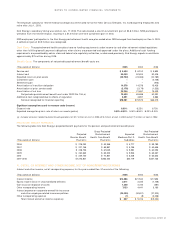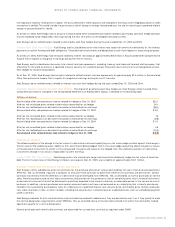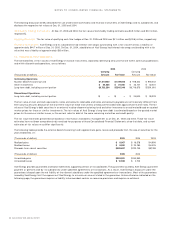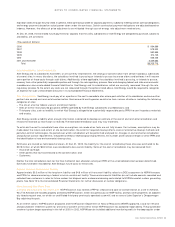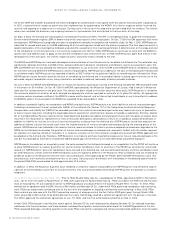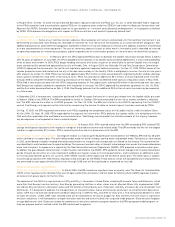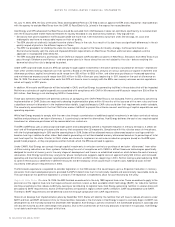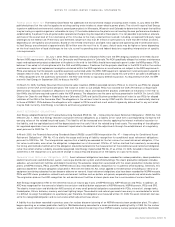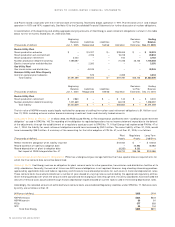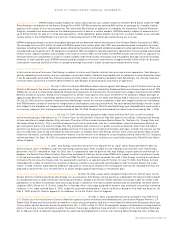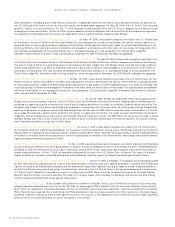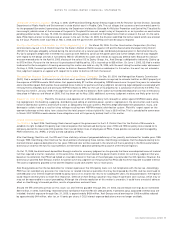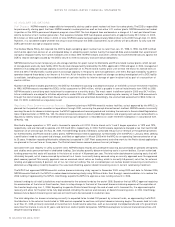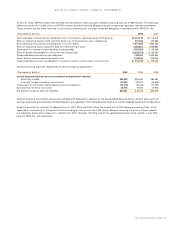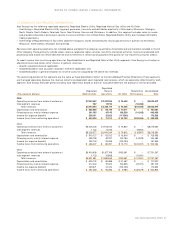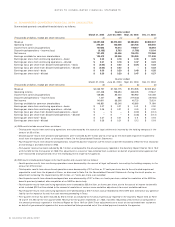Xcel Energy 2005 Annual Report Download - page 74
Download and view the complete annual report
Please find page 74 of the 2005 Xcel Energy annual report below. You can navigate through the pages in the report by either clicking on the pages listed below, or by using the keyword search tool below to find specific information within the annual report.On July 11, 2005, SPS, the City of Amarillo, Texas and Occidental Permian LTD filed a lawsuit against the EPA and a request for reconsideration
with the agency to exclude West Texas from the CAIR. El Paso Electric Co. joined in the request for reconsideration.
Xcel Energy and SPS advocated that West Texas should be excluded from CAIR because it does not contribute significantly to nonattainment
with the fine particulate matter National Ambient Air Quality Standard in any downwind jurisdiction. They argued that:
– Emissions from plants located in the Texas panhandle are more than 1,000 kilometers away from cities like Chicago, St. Louis and
Indianapolis and have no measurable impact on their air quality.
– The EPA should not arbitrarily include the entire state of Texas in the rule. As a result of its size, there are significant differences in the air
quality impact of plants in the different regions of Texas.
– The EPA has precedent for dividing the state into two regions. As part of the Texas Air Quality strategy, the Texas Commission on
Environmental Quality split the state and imposed different requirements on West Texas. The Bush administration adopted a similar
approach in its proposed Clear Skies Act.
– The EPA excluded Oklahoma and Kansas from CAIR, but imposes CAIR’s burdens on plants in West Texas. Emissions from West Texas must
pass through Oklahoma and Kansas – and over power plants in those states that are not subject to the rule – before reaching the
downwind cities the rule is designed to protect.
Under CAIR’s cap-and-trade structure, SPS can comply through capital investments in emission controls or purchase of emission “ allowances”
from other utilities making reductions on their systems. Based on the preliminary analysis of various scenarios of capital investment and
allowance purchase, capital investments could range from $30 million to $300 million, and allowance purchases or increased operating
and maintenance expenses could range from $20 million to $30 million per year, beginning in 2011, based on the cost of allowance on
Feb. 15, 2006. This does not include other costs that SPS will have to incur to comply with the EPA’s new mercury emission control regulations,
which will apply to SPS’ plants.
In addition, Minnesota and Wisconsin will be included in CAIR, and Xcel Energy has generating facilities in these states that will be impacted.
Preliminary estimates of capital expenditures associated with compliance with CAIR in Minnesota and Wisconsin range from $30 million to
$40 million. Xcel Energy is not challenging CAIR in these states.
These cost estimates represent one potential scenario on complying with CAIR if West Texas is not excluded. There is uncertainty concerning
implementation of CAIR. States are required to develop implementation plans within 18 months of the issuance of the new rules and have
a significant amount of discretion in the implementation details. Legal challenges to CAIR rules could alter their requirements and/or schedule.
The uncertainty associated with the final CAIR rules makes it difficult to project the ultimate amount and timing of capital expenditures and
operating expenses.
While Xcel Energy expects to comply with the new rules through a combination of additional capital investments in emission controls at various
facilities and purchases of emission allowances, it is continuing to review the alternatives. Xcel Energy believes the cost of any required capital
investment or allowance purchases will be recoverable from customers.
The EPA’s CAMR also uses a national cap-and-trade system and is designed to achieve a 70 percent reduction in mercury emissions. It affects all
coal- and oil-fired generating units across the country that are greater than 25 megawatts. Compliance with this rule also occurs in two phases,
with the first phase beginning in 2010 and the second phase in 2018. States will be allocated mercury allowances based on coal type and their
baseline heat input relative to other states. Each electric generating unit will be allocated mercury allowances based on its percentage of total
coal heat input for the state. Similar to CAIR, states can choose to implement an emissions reduction program based on the EPA’s pro-
posed model program, or they can propose another method, which the EPA would need to approve.
Under CAMR, Xcel Energy can comply through capital investments in emission controls or purchase of emission “ allowances” from other
utilities making reductions on their systems. Estimating the cost of compliance with CAMR is difficult because technologies specifically
designed for control of mercury are in the early stages of development and there is no established market on which to base the cost of mercury
allowances. Xcel Energy’s preliminary analysis for phase I compliance suggests capital costs of approximately $20 million and increased
operating and maintenance expenses ranging between $10 million and $20 million, beginning in 2010. Further testing is planned during 2006
to confirm these costs or determine if different measures will be necessary, which could result in higher costs. Additional costs will be
incurred to meet phase II requirements in 2018.
The Minnesota Legislature is expected to consider legislation in the 2006 session that could require up to a 90 percent reduction in mercury
emissions from coal-fueled power plants, provided the MPUC determines that it is technically feasible and economically reasonable to do so.
The cost impact of this potential legislation is unknown. The legislation is expected to allow for cost recovery by the utility.
Regional Haze Rules
On June 15, 2005, the EPA finalized amendments to the July 1999 regional haze rules. These amendments apply to the
provisions of the regional haze rule that require emission controls, known as best available retrofit technology (BART), for industrial facilities
emitting air pollutants that reduce visibility by causing or contributing to regional haze. Xcel Energy generating facilities in several states will
be subject to BART requirements. Some of these facilities are located in regions where CAIR is effective. CAIR has precedence over BART.
Therefore, BART requirements will be deemed to be met through compliance with CAIR requirements.
States must develop their implementation plans by December 2007. States will identify the facilities that will have to reduce emissions under
BART and then set BART emissions limits for those facilities. Colorado is the first state in Xcel Energy’s region to earnestly begin its BART rule
development as the first step toward the December 2007 deadline. Xcel Energy is actively involved in the stakeholder process in Colorado and
will also be involved as other states begin their process. Due to the uncertainties of the many decisions involved in this process, Xcel Energy
is not able to estimate the cost impact at this time.
72 XCEL ENERGY 2005 ANNUAL REPORT
NOTES TO CONSOLIDATED FINANCIAL STATEMENTS



